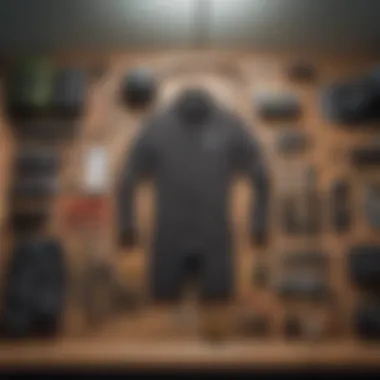Ultimate Winter Wetsuit Guide for Kitesurfing & Kiteboarding


Intro
Choosing the right winter wetsuit is crucial for kitesurfers and kiteboarders who want to navigate colder waters effectively. This guide aims to articulate key factors that inform wetsuit selection and maintenance, ensuring that enthusiasts can maximize their performance and comfort during winter sports. Understanding wetsuits' material, thickness, and fit plays a vital role in enhancing the overall cold-weather experience. By equipping readers with detailed information and insights into various models and brands, this article seeks to facilitate informed decision-making.
Additionally, throughout this comprehensive guide, readers will find practical tips for ongoing wetsuit care and maintenance techniques. These actions ensure the longevity of the wetsuits while maintaining optimal warmth and flexibility, which are essential for winter activities. We will provide an exploration of specific models from noted brands, including technical specifications and practical use tips to cater to varying experience levels.
The task at hand is profound—acknowledging that even within a specialized field such as kitesurfing, the equipment remains Central to the athlete's experience is crucial. Every season, developments in technology continually affect athletes’ choices and performance. This section sparks a deeper conversation on selecting winter wetsuits and considers other necessary gear supporting kitesurfing activity. With the growing popularity of winter kitesurfing, understanding what it takes to choose the right suit becomes imperative.
Equipment Reviews
Selecting suitable equipment for winter kitesurfing and kiteboarding involves several factors. Specific temperature ranges, water conditions, and kite as well as board responsiveness interact mariginaly with the chosen wetsuit.
Wetsuits: An Essential Overview
The winter wetsuit stands as the major line of defense against cold water. Materials include neoprene, which trap heat and provide reasonable flexibility. It's important also to conside the suit's thickness. Variable thickness is available, usually ranging from 3mm to 6mm, depending on both water and air temperatures. A coorect fit enhances mobility and reduces water ingress. For kiting in the winter, a tighter suit can save on warmth, but comfort must remain central to regard.
Key Components in Wetsuit Selection:
- Material: Neoprene is standard, with variations offering different insulation properties.
- Thickness: Typically 3mm to 6mm, often dependent on local climate and personal comfort levels.
- Fit: Look for snug, tight fit to limit water entry.
- Functionality: Additional seals and entrance systems can improve overall thermal efficiency.
Brands and Models
There are numerous brands within the wetsuit market that cater to kitesurfing in cold conditions. Notable companies such as O’Neill, XCEL, and Rip Curl lead with their innovative designs and functional choices. Each model features specifications meticulously designed to cater to experienced riders as well as newcomers.
Top Wetsuit Picks for Winter kitesurfing
- O’Neill Psycho Tech - Excellent thermal performance with minimal bulk.
- XCEL Drylock - Offers durability along with state-of-the-art insulation.
- Rip Curl Flashbomb - Focuses on quick drying technology, allowing quick turnarounds in cold weather.
Spending enough time understanding different aspects and developments in wetsuits will better prepare kitesurfers for the conditions ahead. Furthermore, devoting attention to other skiing equipment is essential for complete winter performance.
Understanding Winter Wetsuits
Winter wetsuits are not just an accessory for kitesurfing in cold weather; they are essential gear that impacts performance, safety, and enjoyment on the water. A thoughtfully selected wetsuit can regulate body temperature and minimize risks that cold environments present. As we dive into this section, we will explore some key aspects of winter wetsuits that serious kitesurfers and kiteboarders must comprehend.
The Importance of Winter Wetsuits
A properly fitting winter wetsuit provides thermal insulation. It allows kitesurfers to enjoy their sport even when temperatures hover below the comfortable levels. The reduction of heat loss is a vital functionality; if the body temperature drops too much, it could lead to hypothermia. This danger is especially pertinent for extended sessions on the water.
Moreover, a good wetsuit enhances mobility. While staying warm is crucial, kitesurfers must still have a wide range of motion in order to maneuver and perform their tricks. Therefore, understanding the balance between insulation and flexibility is fundamental when choosing a winter wetsuit.
Weather and water conditions differ; these variations necessitate adaptability. Riders should familiarize themselves with how seasonal factors influence their performance and risk exposure when in colder climates.
How Cold Water Affects Performance
Cold water can significantly reduce physical performance. When exposed to low temperatures, muscle fatigue sets in more easily, affecting both stamina and strength. Kitesurfers might find that their response times are slower, directly influencing their maneuvers. Concentration decreases as cold sets in, making it more challenging to focus on the sport.
Additionally, enjoyment of kitesurfing should not be underrated. Water temperatures below the comfort threshold can cause discomfort, taking away from the thrill of the sport. Choosing a specific winter wetsuit helps counter these negative effects, providing a barrier to chill and enabling extended practice periods without sacrificing body functionality.
Essential Features of Winter Wetsuits
When considering winter wetsuits, certain features rise to prominence:
- Thickness and Material: Winter wetsuits generally range in thickness from 4mm to 6mm for optimal warmth. Prices can increase for materials like Neoprene focused on durability and insulating capabilities.
- Seam Construction: Sealed seams or stitched seams ensure that water ingress is minimal, critical for staying warm in colder waters.
- Zippers and Access: Back and chest zippers can affect ease of use. Key features might include water repellence that reduces water entry.
It is crucial to address the compression and fit of the wetsuit. A well-fitted wetsuit minimizes water speed entering for cooling effects and maximizes insulation properties. Opting for features like ankle seals and wrist seals ensures a snug fit to lock in warmth effectively. Kitesurfers who invest time in understanding these essential attributes will ultimately improve their performance and overall experience in winter kitesurfing.
Materials Used in Winter Wetsuits
Understanding the various materials used in winter wetsuits is crucial for maximizing performance and maintaining comfort during kitesurfing in colder conditions. The right materials can influence thermal insulation, flexibility, and overall durability. A wetsuit should be both functional and comfortable, allowing for a remarkable water experience. Each material serves specific function that should not be overlooked.


Neoprene Variations
Neoprene is the most commonly used material in wetsuits. There are several variations of neoprene available, each offering distinct qualities. Traditional neoprene is known for good insulation but can be thick and less flexible. Modern innovations have led to a range of lighter and more stretchable neoprene alternatives:
- Closed-cell neoprene: Offers higher buoyancy and flexibility, making it great for aggressive movements in cold water.
- Open-cell neoprene: Generally more comfortable next to the skin but tends to absorb water, which means it may be less warmer in prolonged exposure.
- Aero and super stretch types: Designed to provide significant flexibility and minimal water retention, ideal for performance-focused riders.
Ultimately, the selection of neoprene should align with your personal style and the water temperature conditions you will frequently encounter.
Lamination Techniques
The lamination process refers to how layers of various materials are bonded to the neoprene. This has a direct impact on water resistance, warmth, that performance on the water. Here are the typical techniques:
- Flatlock seams: Provides durability but can allow water to seep through.
- Glide skin seams: These are watertight and help trap warmth but potentially limit flexibility
- Blind stitched seams: This technique keeps you warmer as the stitching does not go all the way through the material, decreasing water entry point.
Choose the right seam construction based on your prioritization of warmth versus flexibility on the water. Quality lamination increases both the longevity and effectiveness of your wetsuit under cold conditions.
Eco-friendly Options
More environmentally-friendly fabrics are gaining prominence in the industry as awareness around fossil fuel dependence heightens. These alternatives minimize environmental impact without sacrificing quality. Here are notable eco-friendly materials to consider for your wetsuit:
- Yulex rubber: Made from natural rubber rather than neoprene. It is more sustainable and provides notable warmth.
- Recycled polyester linings: Often utilize PET plastics, increasing the sustainability of manufacturing processes.
Choosing environmentally-conscious materials benefits both the kitesurfer and the larger ecosystem. Adopting more sustainable practices allows for healthier water, all while still providing excellent thermal and performance characteristics.
Wetsuit choice is not just about personal comfort; it’s also about the impact you want to have on your surroundings while enjoying the sport you love.
Selecting the Right Thickness
Selecting the appropriate thickness for a winter wetsuit is critical. The thickness not only influences heat retention but also affects one’s comfort and mobility while kiting in cold waters. Kitesurfing demands agility and precision, and choosing a wetsuit that allows for both warmth and flexibility can significantly enhance performance. It is essential to grasp what thickness rating means to ensure an optimal experience outdoors during winter months.
Understanding Wetsuit Thickness Ratings
Wetsuit thickness is usually measured in millimeters and presented as a two-number format, such as 4/3 mm or 5/4 mm. The first number refers to the thickness in mm of the suit's torso, while the second number indicates the thickness around the extremities, like arms and legs. For instance, 4/3 mm means the torso is 4 mm thick for insulation, while the limbs are 3 mm thick for enhanced flexibility. This configuration supports warmth while maintaining freedom of movement.
When choosing a thickness, consider both personal tolerance to cold and the expected environmental conditions. Various brands and models may carry slight variations in these thickness ratings, making it prudent to try on multiple options before settling on a design. It is wise to check for lining materials as well, because various fabrics can add warmth with less thickness while ensuring good comfort.
Recommended Thickness by Water Temperature
Selecting the right thickness generally should correlate with water temperature. As a guide, one could use the following recommendations:
- Above 70°F (21°C): 2/2 mm suits or shorties, providing minimal insulation with comfort from the warmth.
- 60°F to 70°F (15°C to 21°C): 3/2 mm suits are suitable as these offer better insulation while still permitting good movement.
- 50°F to 60°F (10°C to 15°C): 4/3 mm suits or even 5/4 mm could be required to fend off the cooler water.
- Below 50°F (10°C): A thicker suit of 5/4 mm or a drysuit is optimal, ensuring maximum insulation against very cold conditions.
Ultimately, matching wetsuit thickness to water temperature ensures better heat retention. This ensures responsible and enjoyable kitesurfing experiences even in extreme environments. Consider also the wind chill factor when deciding on suitability, as one may often wear a thinner suit but confront colder feels due to wind.
Tip: For those determining thickness by seasonal changes, keep in mind that layers can oftentimes supplement the thinness— disappearing during spring hits after braving the winter chills.
Fit and Comfort Considerations
Fit and comfort are critical aspects when selecting a winter wetsuit for kitesurfing. A wetsuit that does not fit properly can greatly affect both performance and enjoyment on the water. Understanding why fit matters, along with the various styles available, plays a vital role in making an informed decision.
Importance of a Proper Fit
A proper fit in a wetsuit is essential for several reasons. First and foremost, water resistance maintains your body warmth, a vital factor in cold conditions. A wetsuit that is too loose will allow water to flow in and out, stripping you of valuable heat. Conversely, a suit that is too tight may restrict movement and impact blood circulation.
Benefits of the Right Fit
- Insulation: An ideal fit keeps a thin layer of water next to the skin, which warms up quickly, providing some insulation against cold.
- Flexibility: Tight compression may hinder movement, but a suit with the right fit ensures both comfort and ease of movement during kitesurfing maneuvers.
- Performance: A well-fitted wetsuit will enhance your hydrodynamics in water, promoting better speed and agility.
Factors to Consider


- Measurement: Different brands may have varying sizing charts, so precise measurements are critical. Consider skintight fits yet enough tensile stretch.
- Taping and Stitching: Seams that minimize water entry and maintain flexibility are essential.
- Try Before You Buy: Testing the suit can indicate whether it provides the necessary movement and comfort.
Different Wetsuit Styles
The style of a wetsuit can influence not just comfort, but functionality as well. Here are a few common types:
- Full Suits: Cover your entire body. They provide maximum insulation, making them best for the coldest waters. You may feel restricted but remain warm.
- Shorties: These suits have short arms and legs, allowing more freedom of movement. Good for milder conditions.
- Sleeveless Designs: Favorable for those who prefer maximum mobility in their arms, these styles can provide a nice balance between insulation and flexibility.
- Spring Suits: Suitable for transitional seasons, they offer a balance for warmer air and cooler waters while allowing some body parts exposure.
Each style has its pros and cons, and which is right for you depends on a mix of personal preference and the specific conditions that you face while kitesurfing. When out on cold waters, fit combined with the right style ensures comfort and an enhanced experience on your board.
A fitted wetsuit is not just about being snug; it’s about achieving an optimal balance between warmth and agility.
Learning about these aspects contributes significantly to maintaining performance in the thrilling world of kitesurfing.
Key Brands and Recommended Models
Selecting the right winter wetsuit significantly impacts your kitesurfing and kiteboarding experience. The harsh conditions of cold water require reliable gear from established brands with proven performance and quality. Here, it is essential to highlight the top brands in the market and their recommended models to assist in making an informed decision. Understanding specific strengths of different brands and models can guide enthusiasts in investing wisely, ensuring comfort and performance in challenging climates.
Top Brands for Winter Wetsuits
Various brands specialize in winter wetsuits, each with unique technologies, designs, and user testimonials. Choosing a reputable brand correlates with quality, functionality, and durability.
- O'Neill: Known for its innovative designs, O'Neill offers excellent insulation through their exclusive thermal materials.
- Rip Curl: This brand emphasizes mobility without sacrificing warmth, producing suits like the Flashbomb series, which is renowned for its rapid drying properties.
- Gul: Gul is famous for their affordability paired with durable designs. Their Celestial range integrates a firewall for enhanced heat retention.
- Mistral: Mistral wetsuits provide extensive options tailored to both beginners and seasoned surfers, prioritizing comfort.
- Xcel: Xcel wetsuits incorporate advanced technology in seam sealing, ideal for intense kitesurfing sessions in cold water.
Understanding product ranges within these brands is crucial for meeting personal needs based on activity level and weather conditions. Their long-standing histories contribute to substantial development in thermal management and flexibility indicated in performance.
Model Comparisons
When evaluating specific models from each brand, various factors emerge as important for selecting the ideal winter wetsuit. Comparing attributes like thermal climate control, flexibility, and price point aids consumers in making thoughtful choices.
O'Neill Psycho Tech /
- Type: Chest zip
- Thickness: 5/4mm
- Benefit: Exceptional thermal properties, great mobility, and durability. Ideal for extreme cold.
Rip Curl Flashbomb /
- Type: Chest zip
- Thickness: 5/4mm
- Benefit: Fast-drying lining and minimal water absorption, offering warmth in shifting temperatures.
Xcel Drylock /
- Type: Chest zip
- Thickness: 5/4mm
- Benefit: Unique outer skin provides unbeatable warmth and comfort while remaining flexible during activity.
Gul G10 Tech /
- Type: Back zip
- Thickness: 5/3mm
- Benefit: Balanced warmth and lightweight, this model is suitable for less extreme cold but still retains performance.
Mistral Matrix Prime /
- Type: Chest zip
- Thickness: 4/3mm
- Benefit: Comfort and value aimed at entry-level users with considerations for warmth in cooler water.
These comparative insights serve as a pragmatic approach to identifying the best fit for your kitesurfing activities in winter conditions. Evaluating options allow tailored decisions aligned with the user’s unique requirements and style, enhancing performance on the water.
Consider research from independent reviews and personal tests. This can provide practical evidence beyond manufacturer claims, assisting to uphold factors like customer service quality and post-purchase support.
The selection of a wetsuit affects not only performance but overall enjoyment and ability to engage in kitesurfing in colder temperatures. Taking inherent features and brand reliability into account is vital for every extreme athlete.
Maintenance and Care for Winter Wetsuits
Maintaining a winter wetsuit is essential for ensuring its longevity and performance, especially for kitesurfers and kiteboarders who often expose their gear to harsh conditions. Cold water usage can wear down materials, reduce flexibility, and decrease insulation effectiveness. Therefore, following proper care guidelines allows athletes to benefit from optimal functionality and increased durability.


Cleaning Guidelines
Keeping your wetsuit clean is a key aspect of maintenance. Saltwater, sand, and other debris can accumulate on the fabric and lead to unpleasant odors or fabric degradation. Here are specific steps to ensure proper cleaning:
- Rinse After Each Use: Always rinse with freshwater immediately after using your wetsuit. This step helps remove salt and impurities before they can harm the material.
- Use Mild Soap: If necessary, employ a mild soap specifically formulated for wetsuits. This further removes any bacteria or odors that may linger.
- Avoid a Washing Machine: Do not machine wash your wetsuit. This can damage seams and stretch the material unreasonably. Hand cleaning is safer.
- Air Dry: Let the wetsuit air dry away from direct sunlight. UV rays can degrade materials so it's good to dry it inside-out, too. This practice maintains elasticity and prevents fading.
Remember: Proper and consistent cleaning prolongs the life of your wetsuit and sustains its performance.
Storage Recommendations
Proper storage is critical particularly during the off-season. Follow these guidelines to keep your suit in prime condition:
- Flat or Hanging Storage: Store your wetsuit flat or hung on a wide hanger. This practice avoids creasing and distorts shape, ensuring it retains flexibility and fit over time.
- Avoid Compressive Environments: Keep the wetsuit away from tight spaces or heavy weights that may compress the material. Such environments can prioritize damage.
- Climate Control: Place your wetsuit in a cool, dry place. High humidity can promote mildew or mold, which is troubling not just for the suit's condition but also hygienically.
- Inspect Regularly: Check the suit regularly for any damages like punctures or seam issues. Addressing these promptly can save your wetsuit from becoming irreparable.
Staying diligent in shiny your wetsuit through proper care practices empowers kite surfers to ensure both performance and protection for many winters to come. Each point enumerated here addresses key aspects of maintenance that support both practicality and safety when engaging in extreme sports.
Tips for Kitesurfing in Cold Weather
Kitesurfing in winter can be challenging but also rewarding. Proper preparation and the right techniques can make a difference in enjoyment and safety. Whether you are a seasoned practitioner or just starting, following some essential tips for cold weather kitesurfing will help you maximize fun while minimizing risk.
Layering Techniques
Layering is a fundamental strategy to ensure warmth during frigid sessions. It is not enough to wear only a wetsuit; the right layers underneath enhance insulation without restricting movement. Consider using thermal rash guards or wetsuit tops made with materials that dry quickly and retain body heat.
- Base Layers: Start with a thin base layer close to your skin. Fabrics like polyester or merino wool wick moisture away while providing warmth.
- Mid Layers: Next, choose a thicker layer, like a fleece, that can trap heat effectively. Its purpose is to add insulation, so ensure that it fits well beneath your wetsuit.
- Outer Layers: For wind protection, a shell jacket is advisable. It acts as a barrier against the cold wind while maintaining breathability.
By integrating these layering principles, timeless adjustment can be made with variable weather changes, maintaining a balance on comfort and performance.
Staying Warm on the Water
Being in the water for extended periods can quickly expose any weaknesses in your warmth strategy. Here are crucial ways to manage and maintain warmth while kitesurfing:
- Wetsuit Accessories: Don’t neglect accessories. Booties, gloves, and hoods can be significant. A great recommendation is to choose neoprene accessories that match or exceed the thickness of your wetsuit.
- Control Your Exposure: Keep track of how long you are on the water. Frequent breaks allow your body to adjust. Cold fingers and extremities can easily reduce your control over the kite.
- Movement and Flexibility: Keeping your blood circulation running is vital. Perform light exercises and stretch to minimize fatigue and maintain the mid-range bright sensation. Staying active supports warmth and spirit.
- Plan the Time: If possible, time your sessions around peak sunshine hours. Daylight helps create less shock from extremely cold water.
“The difference between an average session and a great one often comes down to the details of preparation.”
These approaches serve to create a better experience regardless of ambient conditions. With planning, patience and vigilance, cold weather kite-surfing can unfold delightful moments against the backdrop of a winter wonderland.
Common Myths About Winter Wetsuits
Understanding the myths surrounding winter wetsuits is crucial for kitesurfers. Misinformation can lead to poor choices when selecting a wetsuit, negatively affecting comfort and performance on the water. These misconceptions, often derived from outdated practices or personal anecdotes, can mislead both new and experienced riders. Addressing these myths will provide clarity and help kitesurfers make informed decisions. Consideration of actual facts can improve the overall kitesurfing experience in cold weather conditions.
Debunking Misconceptions
Several common myths about winter wetsuits can lead to misunderstandings. Here are some prevalent ones:
- Wetsuits are always too warm: Many believe that a winter wetsuit is designed to keep the wearer too hot. In reality, wetsuits help moderate body temperature and prevent heat loss in cold conditions.
- Thicker means warmer: People often think that selecting the thickest wetsuit will ensure maximum warmth. However, the right thickness depends on water temperature and personal comfort. Thicker suits can limit movement, affecting overall performance.
- All wetsuits last for years untouched: Another myth is that a wetsuit will remain in top condition for years if it’s not used often. In fact, the neoprene material can deteriorate over time, regardless of use. Proper maintenance is required to extend the wetsuit's lifespan.
- You can just layer up casual clothes underneath: Some riders opt for casual gear underneath their wetsuits believing this keeps them warm. Layering inappropriate materials can actually create discomfort and make it difficult to move freely.
- Once wet, wetsuits do not insulate: Many feel that a wetsuit loses its effectiveness once water infiltrates it. Although some water enters, the layer of water between the suit and skin will warm up due to body heat, providing insulation.
Summary of Misconceptions
Kitesurfers should be aware of these myths. Understanding the realities behind wetsuit technology will enhance their riding experience in colder conditions. Choosing the right wetsuit, maintaining it properly, and recognizing its actual function serves to ensure safety and comfort, ultimately leading to a more enjoyable session on the water.
The End: Making the Right Choice
Choosing a winter wetsuit for kitesurfing and kiteboarding is a critical step that involves several factors. Performance, comfort, and durability all hinge on making the right selection. The consequences of a poor choice during the colder months can mean facing the elements unprotected, leading to a compromise in performance and even safety. The trick is to identify which elements are priorities for you as a rider, depending on where and how often you plan to kitesurf.
Summary of Key Considerations
When selecting a wetsuit, keep the following factors in mind:
- Material Quality: Neoprene variations greatly affect warmth and flexibility. Examine options like Yamamoto neoprene; it is lighter and often warmer compared to traditional types.
- Thickness: Proper thickness related to the water temperature is paramount. For frigid waters, a thicker wetsuit will provide better insulation.
- Fit and Comfort: The wetsuit should fit snugly but not restrict movement. A well-fitted wetsuit reduces water circulation, enhancing warmth.
- Functionality: Look for features such as sealed seams, zippers designed for limited water entry, and vents for easy removal. These contribute to the overall effectiveness of the wetsuit.
- Maintenance and Care: Regular cleaning and the correct storage of your wetsuit can extend its life by preventing degradation of materials over time.
Through individual research and testing, riders can certainly impact their overall kiting experience. Expertise comes from real-world use, and understanding each aspect of your wetsuit can maximize both enjoyment and safety on the water.
Effective preparation can lead to an enjoyable session regardless of winter conditions.







